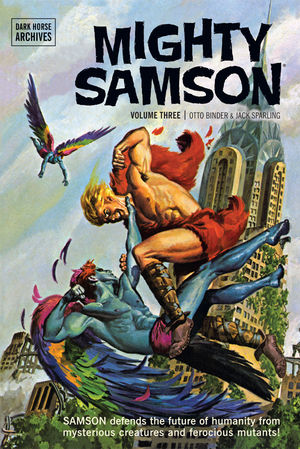 “In the fantastic world where deep, tropical jungle has overgrown the ruins of a once great city, the tribespeople, decedents of the survivors of a nuclear war, often hold primitive feasts! Mindor, Sharmaine and Mighty Samson are guests at such a feast, when suddenly…”
“In the fantastic world where deep, tropical jungle has overgrown the ruins of a once great city, the tribespeople, decedents of the survivors of a nuclear war, often hold primitive feasts! Mindor, Sharmaine and Mighty Samson are guests at such a feast, when suddenly…”
—There was some kind of indiscriminate danger the Mighty Samson would have to crush with his perfectly sculpted quads or well-placed right hook.
This Gold Key comics Silver-Age classic, “Mighty Samson,” first written by comic legend Otto Binder, later picked up by Jack Abel and drawn by both Jack Sparling and José Delbo in similar fashion, was quite the spectacle in the 1960s.
Mighty Samson, himself, was a super-strong He-Man-esque character embodying every positive male stereotype under the sun. Not to mention, at the time of its publishing, the Cold War realities of nuclear destruction were an ever-present threat, which added yet another layer of reader involvement. As the years piled on, however, “Mighty Samson,” flanked by the instantly recognizable heroes of much greater fame (The Avengers, Hulk, Spiderman, Superman, etc.), fell upon the wayside of many a casual comic-book aficionado’s attention.
That is, until its recent re-release under the Dark Horse banner as a part of a four-volume anthology to hype the upcoming rehash of “Mighty Samson” by the same company.
To return to this series is understandable. Plot lines in “Mighty Samson” are basic and self-contained, often not running more than two issues at a time and the simplistic, yet fantastical backdrop of the story is rather exploitable.
Samson’s origin story follows that of many a superhero. He was born with miraculous powers (radiation induced) and, upon the death of a parent (his mother), he swore to protect the weak and vulnerable from peril.
However, this is where many of the similarities end.
Samson was born in N’Yark, a post-apocalyptic rainforest where New York City once stood, immediately gripping the reader with recognizable, but corrupted locales. Oftentimes, in this volume, he is tasked with defending the people of N’Yark from mutants, “half-men,” gargantuan beasts and the dastardly Terra of Jerz, evil queen of what was once Jersey City, across the Hudson River.
At the end of every issue involving Terra, Samson lets her shuttle back to Jerz in her personal UFO to continue her evil, plot-providing foibles.
Of course, not without Samson, his scientist companion Mindor, or Mindor’s perpetual damsel-in-distress daughter, Sharmaine, delivering some interesting Aesop-esque educational message for Terra to chew on.
To the untrained eye, the comic reads like some hilarious old propaganda from the ‘60s. The level of kitsch in these pages will make any hipster squeal with joy.
Nevertheless, outside of the unbelievably grandiose beastie battles, Samson’s ambiguously disappearing and re-appearing eye-patch and contrived “But then!” scene transitions, there is actually a fair amount of children’s educational material within these pages. Not just the blatantly informative Gold Key “Dinosauria” and “Lost Civilizations” single-page shorts.
Samson is often informed of “the past” context of “historical” locations and artifacts by Mindor or Sharmaine, educating the reader under the guise of educating Samson. Mighty Samson teaches children about basic economics, basic science, sharing, the difference between good and bad, the importance of knowledge and countless other little nuggets of positive information kids should know.
“Mighty Samson,” at its core, is a comic for 1960s-1970s youths. If looked at objectively, devoid of modern adult cynicism and knowledge of ironic humor, it fosters wonder and awe with every page whilst simultaneously teaching children positive values (ignoring the blatant imposition of period gender roles and stereotypes).

Leave a Reply